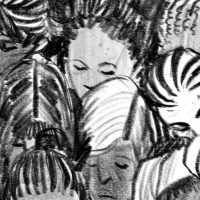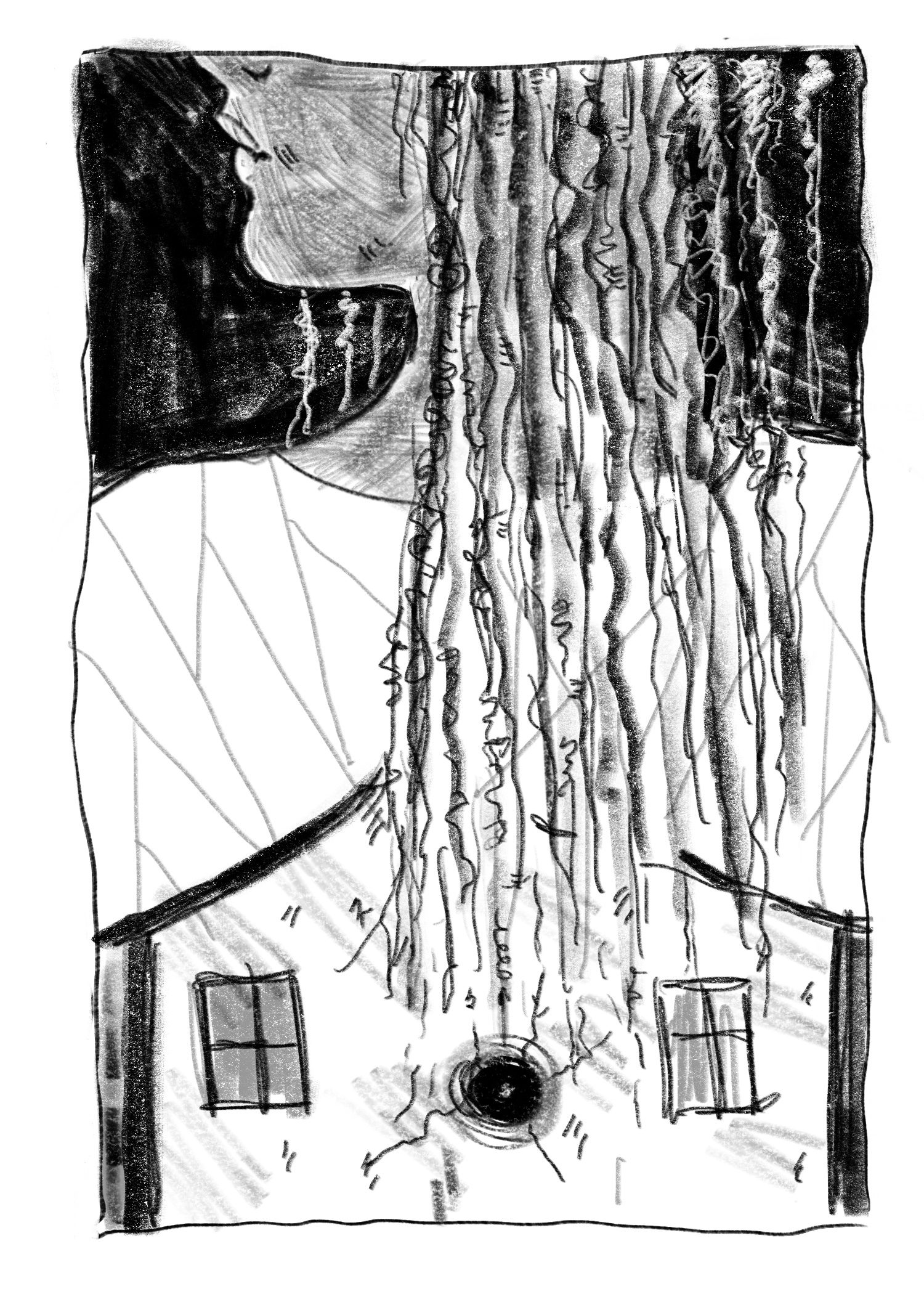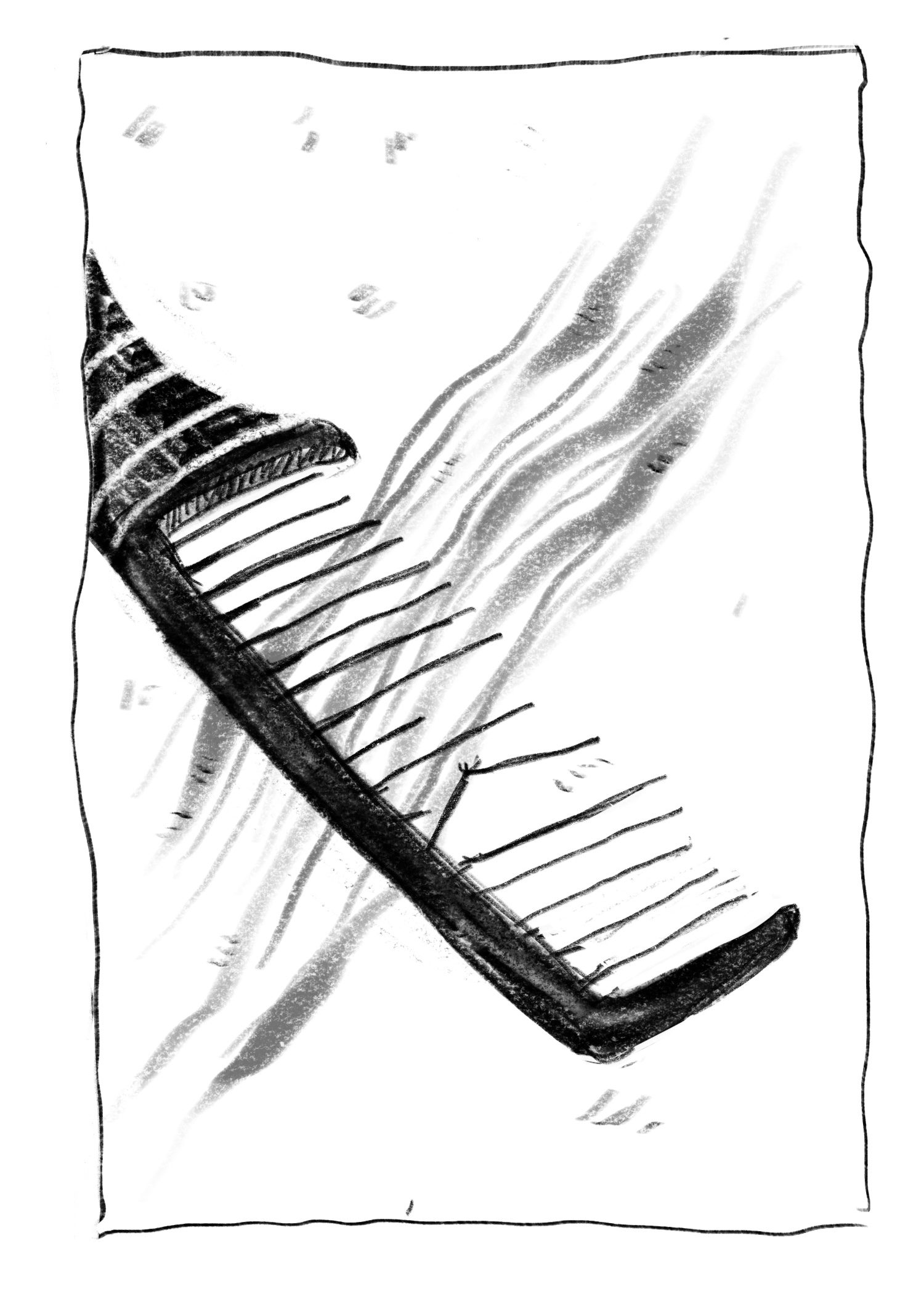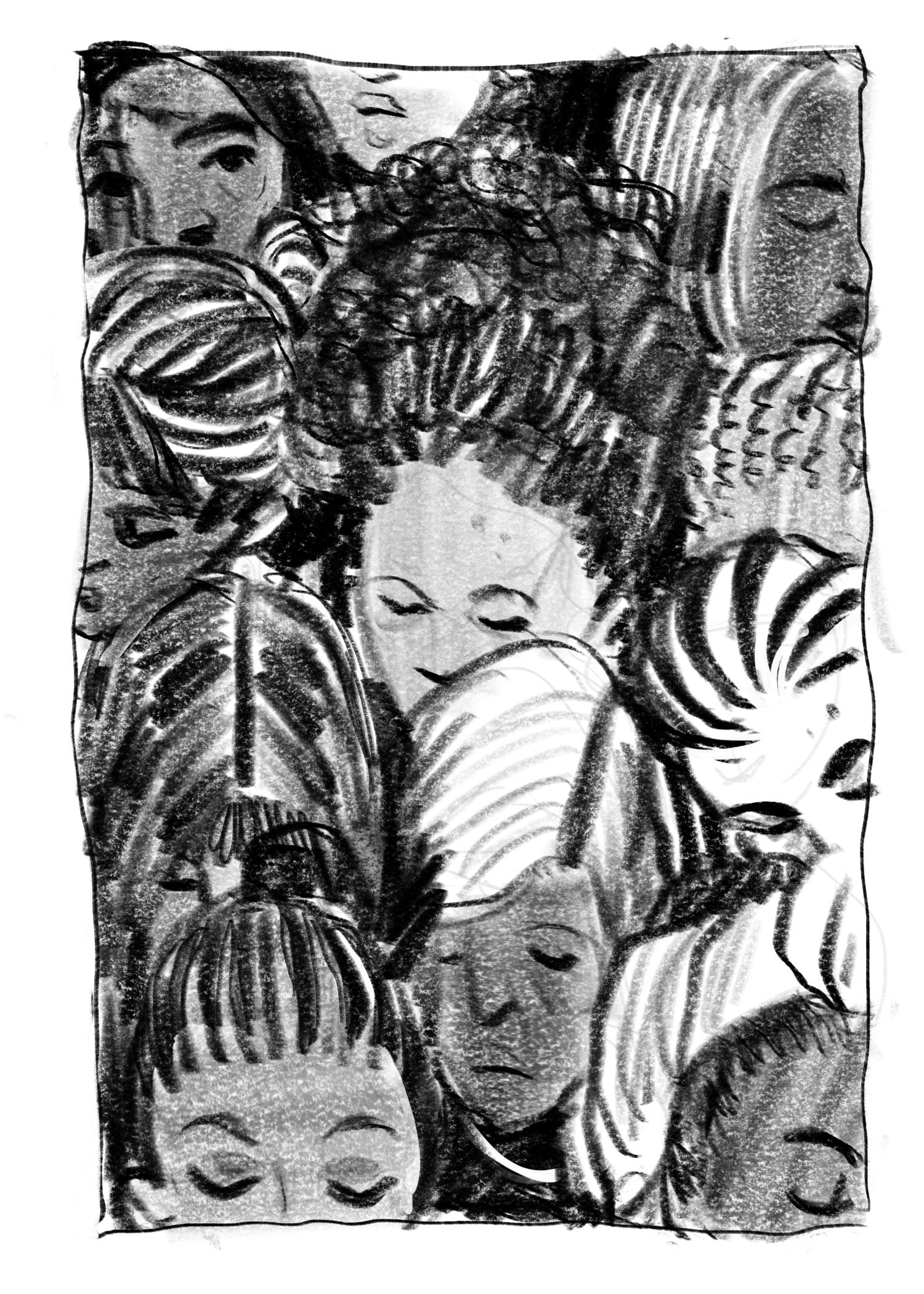At twenty-seven, I sat in a trichologist’s cramped office in a central Abuja and learned I was losing my hair.
The “hair doctor,” a slender, perky woman, moved a handheld device over the top of my head while we stared at narrow strands of hair snaking out from my scalp’s follicles on a computer screen. The strands were dark and shiny, some noticeably thinner than others. In places, they filled the screen like rich shrubbery; in others, they emptied out to vacant holes in my scalp.
“Hmmm,” she said. “Okay, there is some thinning.”
Months prior, my sister had noticed a smooth, small patch while plaiting my hair. She had pressed the pad of her finger into it and said, “Look, you have a bald spot.” I’d raised my hand, touched it, and hopped to my feet. I went to the mirror to peer at it, flashed a light and squinted at it. No, it was nothing. She was not seeing clearly. Perhaps it was a little sparse, but that was how it had always been. I sat down again to finish my hair.
I had actually gone to the trichologist to fix my traction alopecia. Years of tight braids on genetically thin hair had left my left and right temples void besides wispy, transparent hairs. I had followed the doctor on Instagram for some time and yearned for the before and after miracle pictures of her clients’ temples. During the appointment, I told her only as an afterthought, “And I think this is just in my head, but I might be losing hair in other places too.”
“Where?” she asked.
I touched the top of my head and emphasized with a small laugh. “I think it’s just in my head.”
Her announcement that I was right startled me and swept through my body. I felt cold.
There is a picture of me on my first birthday in a pink and white dress, tears streaming down my cheeks, in front of a birthday cake. My hair is loose tufts of wool, long and standing up in the middle and patchy, uncombed micro balls (grus-grus) on the side. The back, though not visible, I know is bald.
This picture was evidence that I had the worst hair among the girls in my family. My older sister had thick, unruly hair that broke combs and stung fingers while it was being plaited, but it was full, something longed for and coveted. My younger sister had hair that was the equivalent of the baby bear’s bed in Goldilocks. Her hair was medium, not too dense or too thin, not too hard that it would break combs and not too fine that extra care would have to be applied to get it to retain length. Mine was always thin and fine, lacking in the volume that made hair beautiful unless I fooled the world with trick hairstyles and braiding patterns that gave it the appearance of being full. It was soft, though. I didn’t even need to relax my hair as most girls did; I only eventually did it in Secondary school because it was on trend.
The picture was proof that from birth I had bad hair, or what my mother and sisters would laugh at and call “chop chop hair”—as though eaten by moths or insects. But a few years before the trichologist, it became proof that I once had the worst hair.
The same traction alopecia that later pushed me to her office had first made me go natural. I swore off chemicals. I washed my hair with conditioner every week because it was less drying for my strands and with shampoo only once a month. I moisturized every day with water, topped it with a water-based leave-in conditioner, and sealed it all in with oil or shea butter. I twisted my hair into two-strand twists as a protective style to reduce breakage caused by frequent handling. I deep conditioned; I did protein treatments. I played around with henna and clay masks. I did everything natural hair YouTube gurus said to do… and my hair thrived.
I, of course, didn’t fix my traction alopecia, but the rest of my hair grew out, hitting armpit length.
It seemed unfair, as I sat in the chair and the trichologist moved the machine over my scalp, that this was happening. After I had finally figured out my hair, after I had poured in money and time and love. The consequence of spending that much time nurturing my hair like a child was that I loved it. And now, after everything, I was losing it.
The trichologist favored a natural approach. I listened to her, as if from far away, explain that she wasn’t big on chemicals but we would start off on minoxidil, the most effective topical stimulant for reviving atrophying follicles, before tapering off to more natural stimulants, such as high-grade essential oil mixes and peptide lotions. I was numb as I processed all the information that was coming at me and felt similar to when, as a child, I would plug my ears with cotton and walk around feeling like there was a buffer between me and the world. I was part of it, but removed from it. The center of this situation, but an observer of it.
We also needed to work on the internal part of things, she said. I had a terrible habit of eating one meal a day, usually after work and usually something lacking in well-rounded nutrition—lots of carbohydrates and protein, little fruit and vegetables. We had to fix that. She had a great natural supplement that would work on suppressing my DHT (dihydrotestosterone, I learned later from Google), the hormone responsible for male and female pattern hair loss, which she suspected mine was, based on its appearance: diffuse thinning at the top of scalp, beginning at my part line. To ascertain if there was an underlying cause though, I was to get blood tests to check my hormone and thyroid levels and abdominal scans to check for cysts on my ovaries, which could be a sign of polycystic ovarian syndrome.
Her tone was assured as she rattled off my course of treatment, which was peppered with success stories and gossip about the other cases she’d seen (a lawyer under a great deal of stress with a poor diet had hair falling out by the fistful, another client’s mother was convinced her daughter’s hair loss was a result of juju—”So if you need me to talk to your family, I can”). She stressed that it would be a long road ahead. Skin could perhaps be healed in a few weeks, but hair would take months, even years.
I had the tests she suggested done three times at three different clinics. The first results revealed elevated hormone and thyroid levels. The second, insisted on by the doctor I went to for hyperthyroidism treatment, stated that they were normal, and the final test confirmed the second. Sometimes there was just no discernible cause, the trichologist told me when I reported back to her. I struggled with that. One of the first questions she’d asked me while examining my scalp during that first appointment was whether there was any history of hair loss in my family, male or female. I’d shaken my head as I thought. “No, none.” It seemed incomprehensible that it would begin with me. And it troubled me an inordinate amount that I would be the one my daughters or sons would point to, sitting in a doctor’s office, as the source of their hair loss. Being the progenitor of a condition that would one day make my children uncomfortable in their bodies was not a position I wanted to occupy. I considered the physical traits handed down to me from my mother that I enjoy, a hallowed connection between us—her finely shaped scalp, her bone structure, her hands. The ability to pass on the negative, marred genes and broken things, seemed like the twisted cousin of a beautiful thing.
I hated not my body but the loss of control over it, and I resented my cells for finding ways to piece together this aberration. More than anything, though, what hounded me was self-directed blame. Despite what the trichologist said, I had to consider that for it to begin with me meant that I may have done something to trigger it—the obvious culprit being my poor diet. And if I had done something to trigger it, then I deserved my situation. The regret of potentially being my own villain was not a thing that fell away easily, or that may ever really disappear fully.
Eventually, I started on the supplements she prescribed: six days a week, resting on Sunday and beginning all over again on Monday. The process was simultaneously exhausting for its repetitiveness and soothing, as each pill was an act of saving myself. I was doing something. I was healing myself every time I swallowed one, giving my body the necessary nutrients it needed to be put back together. It made me optimistic. By the time I finished the last one, I would be back to the person I was prior to the loss of my hair.
I moved on to complete a regimen of minoxidil for three months before switching to a soothing, stimulating peptide cream. After ten months of watching my part line widen to a circle on my scalp, I stopped seeing the trichologist and switched to a hardcore dermatologist, who put me on topical and oral corticosteroids briefly and then on Nizoral shampoo. None of the treatments worked. I didn’t return to the person I was. At present, the crown of my hair still has large portions of barren spaces.
Hair loss affects women more acutely than men, a quick Google search will tell you that. It strikes at our self-esteem, identity, and confidence, which is unsurprising in a world where a woman’s value is attached to her physical attributes, of which hair is an important part.
I think of hair advertisements: Caucasian women (predominantly) with shiny, silky hair (predominantly), which is always long, always healthy. The peak of femininity. I think of those ads and feel an absence of something.
In the weeks after discovering I was losing my hair, my primary feelings were of being somewhat masculine. I worried about my interactions with men. What man would want to be with a woman who was balding? Wouldn’t he feel like he was with a man? I spent quite a bit of time staring at other people’s heads. With sparse heads, I could relate, and with full heads of hair, I felt somewhat envious even though my own looked to be full to the plain eye. I became obsessed with other women’s part lines. Like the part line itself was something to be vilified, I cringed when I saw center parts and wanted the women who had them to cover them up in styles that required no parts. Maybe if there were no part lines there would be nowhere for the loss to begin from.
I discovered that both men and women were acutely disturbed at learning about my hair loss—unsurprisingly, women more so than men. My sisters screamed the first time they saw the bald patch in the middle of my head that had sprung up in tapering from minoxidil to the other stuff. I was still seeing the trichologist then and assured them, “It will grow back.”
Men, even doctors, even the nice ones, are faintly repulsed by it. Something about a woman losing her hair is unnatural, unattractive. They neither want to think about it or be faced with it. In the dermatologist’s office, a young, male doctor shadowing the senior dermatologist grimaced at the sight of my bald patches during an examination. “I hope you are married,” he said as a side note when the important questions were out of the way.
“No, I’m not,” I replied.
“But you have a boyfriend, I’m sure. Better not tell him until you’re married.”
It reminded me of the biblical sentiment “hair is the glory of the woman.” I had ceased being a glorious being. I was now play-acting at being a goddess, hiding parts of myself. Shame was an emotion I wasn’t only expected to live with but to embrace. Covering my hair up wasn’t only a personal decision, but also an externally imposed necessity.
Having grown up Muslim, scarves were part of my every day attire, and being natural, wigs were part of my usual hair care routine, but I wondered about women whose hair had been open their entire lives and the psychological blow the sudden shift to covering it up would cause. That first time would have been brutal.
The loss of choice was what plagued me. I’d loved the texture and aesthetic of my hair in two-strand twists and packed up into a ponytail. I could no longer do any styling and was left to the preferences of what the headpiece marketplace decided was in vogue, and thus what was available. Twisted wigs, braided wigs, straight hair wigs, curly wigs: trying them out in a shop in the crowded Utako market wasn’t as appealing as it had been when I was still in possession of all my hair. It didn’t have the magic of protecting what I had—as wigs are a protective style for naturals. It now had bleakness of covering up what I had lost, along with the fear and vulnerability of worrying what would happen if my covering was ripped off abruptly and people saw who I was underneath. Scarves, I enjoyed. I learned one topknot technique that made me feel fierce and loud, somehow managing to edge out the knowledge of the hair loss and bring me closer to the person I wanted to be.
I know some people believe it’s just hair. That it’s not a big deal. Eff ‘em. Do whatever you want with it: Chop it off, dye it, relax it, don’t relax it— it will grow back, and your worth and value shouldn’t be steeped in your hair. Own your body and don’t let your body own you. The other camp believes that hair has deep and far-reaching social, emotional, and psychological meaning attached to it. It digs down into race, identity, social status, history, and culture, among other things.
But neither of these camps are really talking about hair loss. In the discussion about whether it’s just hair or whether it’s more than just hair, the option of having it at all isn’t considered. I’d like the option before coming to a definitive stance. A stance should be taken from a place of abundance, I think. I can’t say I’m not hungry if I don’t have the option of food. It is what I miss most about my hair: the normalcy of having it. The expectation that having it was the default state, that it was how it should be and how it would always be. I don’t blame anyone for not considering hair loss. It isn’t the rule; it’s the exception. I want to say that I have turned some type of corner. And I suppose in some ways I have. In the beginning, I wouldn’t even let my own family see my hair. I kept it under lock and key (scarves) to avoid being faced with their concern, which would have forced me to face it myself. Now I’ve let it go. I walk around my home with my hair free and open to be seen as it is.
At the same time, sometimes one of them will peer down to my scalp and my chest will constrict. They’ll say something like, “It’s getting better,” but deep down I know it’s not. I see hair in the bath every day; when I touch my head, I see it fall onto my phone screen. I look into the mirror, after hair washes, or as I get dressed, and I see the patch in the middle of my head and feel a weight of despair that it will never grow back, that the barren spaces will continue to increase. The trick is not giving into the despondency. The trick is in straddling the tension between hope and uncertainty.
***
Rumpus original art by Eva Azenaro Acero.







